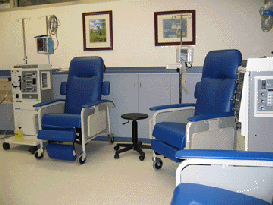Cleaning and Disinfection in the Hemodialysis Setting
The process of physical cleaning of environmental surfaces using detergent (soap), water, and friction is the critical step required prior to surface disinfection. The combination of the cleaning and disinfection processes is designed to remove and kill vegetative microorganisms on surfaces. Disinfection will not be effective in the presence of dirt, blood, or other bio burden. The goal of the cleaning step is to remove bio burden and with it, the majority of pathogens. Disinfection is designed to be a synergistic and somewhat redundant step to ensure comprehensive removal/kill of pathogens on surfaces.
The CDC’s Guideline for Disinfection and Sterilization in Healthcare Facilities, 2008, states that, “noncritical surfaces (e.g., dialysis bed or chair, countertops, external surfaces of dialysis machines) should be disinfected with an EPA-registered disinfectant unless the item is visibly contaminated with blood. In that case, an EPA registered tuberculocidal agent with specific label claims for HBV and HIV should be used.”1 the commonly used disinfectant for blood contaminated environmental surfaces is a 1:100 dilution of bleach (500–600 parts per million [ppm] free chlorine).
The environmental surfaces in HD settings at highest risk of transmitting germs are described using different terms. From the perspective of the patient, the term “patient zone” is used to refer to the surfaces which the patient can touch, or can touch the patient, including the chair, armrests, bedside table top/counter, and drawer/cupboard handles. From the HCW or dialysis staff perspective, the term “high touch surfaces” is used to describe surfaces which are frequently touched by HCWs. These include the same surfaces in the patient zone in addition to others such as the exterior surfaces of the HD machine, computer screens, and keyboards. Cleaning and disinfection of these surfaces (patient zone/high touch surfaces) should be performed between all patient treatments, no matter what the patient diagnosis is, in order to prevent spread of environmentally transmitted pathogens including MDROs (e.g., MRSA, VRE, C. difficile) and bloodborne pathogens (e.g., HBV, HCV). Of note, microorganisms can live for varying periods of time in the environment. MRSA has been documented as viable at 38 weeks on external sterile packaging and VRE at 6 months on a wheelchair. HBV can survive for 7 days in dried blood.
There are certain products and principles which are recommended in order to optimize environmental cleaning in healthcare settings, including HD facilities. These include the following tasks which are typically performed by the dialysis nurse or technician.
• Store cleaner/disinfectant separately from skin antiseptics/patient supplies (separate shelves and below patient supplies to avoid potential contamination).
• Perform hand hygiene before and after cleaning the patient station.
• Don gloves when using cleaner/disinfectants.
• Use one set of cleaning cloths or disposable germicidal wipes for each patient station.
• Use microfiber cloths and mops if possible (more effective cleaning products than regular cotton cleaning cloths).
• Clean all frequently touched or “high touch” surfaces in the “patient zone” between patient treatments (chair, armrests, counters, drawer/cupboard handles, exterior surface of the HD machine)—please note that some of these high touch surfaces may be right outside the patient zone (e.g., computer stations), and must also be cleaned between patient treatments.
• Clean the top of an object first and work down to avoid soiling surfaces just cleaned.
• If using cleaning cloths instead of disposable germicidal wipes:
• When using a disinfectant cleaner, wet the surface, use friction to clean, and allow to air dry.
• Fold the cleaning cloth in a series of squares to provide a number of potential cleaning surfaces. A wadded cloth does not clean efficiently.
• Replace cloth as needed. More than one cloth may be required for a patient station.
• Never use the same cleaning cloth for more than one patient unit.
• Never re-dip used cloth into clean disinfectant solution.
Additional cleaning functions, typically performed by housekeeping staff in HD facilities, should include:
• At the end of the day:
• Wet mop the floor
• Clean patient/staff bathrooms and restock paper products/hand hygiene supplies
• Check and refill all hand hygiene product dispensers in nursing stations and at patient stations (soap, paper towels, lotion, alcohol-based hand sanitizer)
• On a routine basis, walls and high dusting should be performed.
Multi Drug Resistant Organisms Cleaning and Disinfection
Many healthcare workers believe the environment of patients with MDROs require special cleaning. Healthcare workers in HD facilities should clean the environment of the MDRO patient as they would for any patient, as many more patients than are known are colonized/infected with an MDRO. Cleaning involves the use of friction on environmental surfaces to physically remove the soil and germs. The wet contact time of the germicide on the surface helps kill or inactivate any remaining microorganisms. The exception is C. difficile, which requires removal by friction and is not inactivated by any surface disinfectant except bleach.

MRSA is really dangerous because it can evolve or mutate into an even more dangerous strain of super bacteria.**`’;
Regards http://healthmedicinelab.com/sun-poisoning-rash/